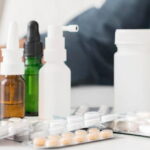Introduction:
ED is the inability to keep the penis erect and firm enough for sex. It’s not always a matter of huge concern while experiencing occasional erection problems. However, if erectile dysfunction persists, it may stress the person out, lower his confidence, complicate relationships, etc. Problems in maintaining an erection while having sex can also result in heart disease and a symptom of an underlying medical illness that needs to be treated.
However, erectile problems can be treated. It can be treated by several ED pills such as Sildenafil (Viagra), Tadalafil (Adcirca, Cialis), Vardenafil (Levitra, Staxyn), Avanafil (Stendra). Not only ED pills, but erectile dysfunction can also be treated with several other procedures- alprostadil self-injection, alprostadil urethral suppository, and testosterone replacement. Another treatment involves penis pumps and penile treatments.
1.1 PDE-5 Inhibitor:
A phosphodiesterase type 5 inhibitor is a vasodilator that prevents cyclic GMP degradation by the cGMP-specific phosphodiesterase type 5 (PDE5) in the smooth muscle cells lining the individuals’ blood arteries supplying various tissues. These medications treat erectile dysfunction by widening the penis’s corpora cavernosa, making it easier to get an erection when sexually stimulated.
The first effective oral medication for ED was Sildenafil. PDE5 is also naturally found in the smooth muscle lining the walls of the pulmonary arterioles, which is why Sildenafil and Tadalafil, two PDE5 inhibitors, have received FDA approval to treat pulmonary hypertension. Clinically approved medications for the treatment of erectile dysfunction include Sildenafil (Viagra), Tadalafil (Cialis), and Vardenafil (Levitra).
Tadalafil is also prescribed for treating benign prostatic hyperplasia, while Sildenafil is also prescribed for managing certain subtypes of pulmonary hypertension. In addition, as per recommendations from The European Society for Vascular Medicine, PDE5 inhibitors have been utilized as a second-line treatment in severe cases of Raynaud’s phenomenon when it is linked to systemic sclerosis.
Krrista is another new age medication family that includes the renowned PDE5 inhibitors vardenafil and dapoxetine.
Krrista contains two active ingredients, Vardenafil for erectile dysfunction and Dapoxetine for preterm ejaculation (PE).
Super Krrista 40+60 Mg, Krrista Power 40+60 Mg, and Extra Super Krrista 20+100 Mg are some of the other strengths of Krrista.
Men with erectile dysfunction or premature ejaculation may benefit by using Krista. With ED, also known as Impotence, it is difficult to get or keep an erection during sexual activity.
2. Krrista: A PDE-5 Inhibitor:
Krrista range of medicines treats erectile dysfunction in men. Erectile dysfunction is alarmingly widespread among men and is projected to become a greater concern with time. Over the past few years, the reasons behind erectile dysfunction have shifted enormously from psychological to organic causes. Â
The organic causes include diabetes mellitus, hypertension, smoking, peripheral vascular disease, pelvic or abdominal surgery (especially prostate surgery), multiple sclerosis, peripheral neuropathy, and Parkinson’s disease.
Although coadministration has not been associated with alterations in the safety or efficacy of either treatment, there is a possibility for negative drug interactions with other medications that inhibit or stimulate CYP3A4. These medications include HIV protease inhibitors, ketoconazole, and itraconazole. Combining PETN with nitrovasodilators like nitroglycerin is not advised because it could result in potentially fatal hypotension. With other antihypertensive medications, PDE5 inhibitors do not interact synergistically.
3.1 Mechanism of inhibition of Krrista:
Nitric oxide (NO) plays a major role in the physiological process of vasodilation that helps Krrista function. Nitric oxide actively advances the production of cGMP in the penile region- a process significant to developing an erection.Â
For instance, during sexual stimulation, significant quantities of NO are released from endothelial cells and penile nerves in the penis. This causes the smooth vasculature of the corpus cavernosum to relax, which results in vasocongestion and a persistent erection. By preventing the body’s natural PDE5 enzyme from degrading cGMP, Krrista extends the effects of this neurotransmitter.Â
Krrista helps men develop a lasting erection and boosts sexual satisfaction. However, one must know that the medicine does not work in absence of sexual arousal.Â
3. Patient preferences:
Clinical judgments are based on various variables. Some doctors will assert that they only rely on research findings, while others will cite their own clinical experience as the only source of information.Â
Doctors now have various oral PDE5 inhibitors, among which Krrista is very effective. It is safe, productive, and available for treating ED in males. Since the outcome of treatment for ED is not dependent on a laboratory finding and cannot be assessed using radiology, it differs from most other areas of medicine in that it relies purely on the patient’s assessment. As a result, only the patients and their partners can truly determine what treatment is “best” for them.Â
Other investigations attempted to infer patient preferences through the observation of prescription data. Men who have originally prescribed Sildenafil as a treatment for ED are less likely to switch to another PDE5 inhibitor than men who are initially prescribed Vardenafil or Tadalafil, according to a review of prescription data from 40,000 pharmacies in the US. 38 In a different UK investigation, the prescription information of 2703 patients who started their treatment for ED with a PDE5 inhibitor was examined.
Conclusion:
ED is very common andhas significant health effects. The most common form of ED medication is a PDE5 inhibitor. Additionally, PDE5 inhibitors, such as Krrista tried new ways to formulate the drugs and hence improved their overall efficacy.
An awareness of the various qualities should be the focus of a conversation between the patient and the provider when choosing an oral PDE5 inhibitor medication. This can increase the possibility that the patient will be satisfied.



3 Comments
I am 6 feet tall and 220 lbs. This shirt fit me perfectly in the chest and shoulders. My only complaint is that it is so long! I
like to wear polo shirts untucked. This shirt goes completely past my rear end. If I wore it with ordinary shorts, you
probably wouldnt be able to see the shorts at all – completely hidden by the shirt. It needs to be 4 to 5 inches shorter
in terms of length to suit me. I have many RL polo shirts, and this one is by far the longest. I dont understand why.
If I wore it with ordinary shorts, you
probably wouldnt be able to see the shorts at all – completely hidden by the shirt. It needs to be 4 to 5 inches shorter
in terms of length to suit me. I have many RL polo shirts, and this one is by far the longest. I dont understand why.
My husband always says that the Lauren polos fit better and last longer than any other brand.I love the new “heathered†color and the price is always excellent through shop